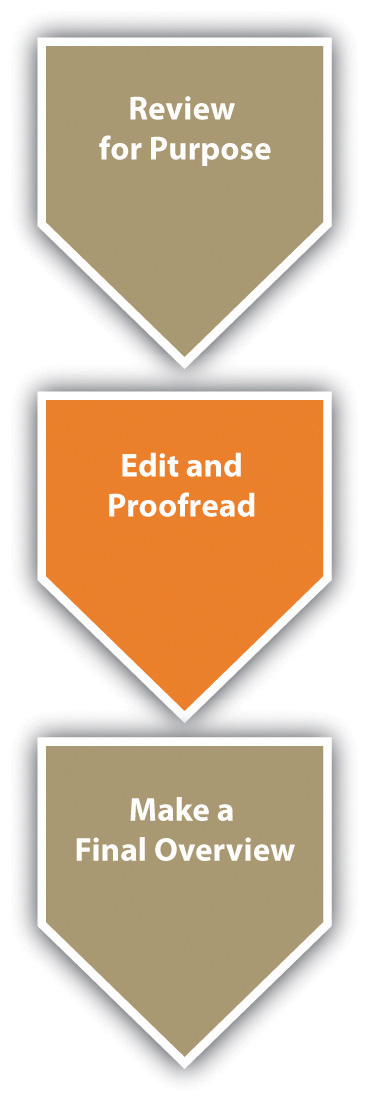This is “Editing and Proofreading”, section 8.2 from the book Writers' Handbook (v. 1.0). For details on it (including licensing), click here.
For more information on the source of this book, or why it is available for free, please see the project's home page. You can browse or download additional books there. To download a .zip file containing this book to use offline, simply click here.
8.2 Editing and Proofreading
Learning Objectives
- Understand why editing and proofreading is important even for careful writers.
- Recognize the benefits of peer editing and proofreading and the similarities between editing and proofreading your work and the work of others.
- Know how to edit and proofread for issues of both mechanics and style.
When you have made some revisions to your draft based on feedback and your recalibration of your purpose for writing, you may now feel your essay is nearly complete. However, you should plan to read through the entire final draft at least one additional time. During this stage of editing and proofreadingReading through text looking for mechanical errors (not content issues). your entire essay, you should be looking for general consistency and clarity. Also, pay particular attention to parts of the paper you have moved around or changed in other ways to make sure that your new versions still work smoothly.
Although you might think editing and proofreading isn’t necessary since you were fairly careful when you were writing, the truth is that even the very brightest people and best writers make mistakes when they write. One of the main reasons that you are likely to make mistakes is that your mind and fingers are not always moving along at the same speed nor are they necessarily in sync. So what ends up on the page isn’t always exactly what you intended. A second reason is that, as you make changes and adjustments, you might not totally match up the original parts and revised parts. Finally, a third key reason for proofreading is because you likely have errors you typically make and proofreading gives you a chance to correct those errors.
Figure 8.2

Editing and proofreading can work well with a partner. You can offer to be another pair of eyes for peers in exchange for their doing the same for you. Whether you are editing and proofreading your work or the work of a peer, the process is basically the same. Although the rest of this section assumes you are editing and proofreading your work, you can simply shift the personal issues, such as “Am I…” to a viewpoint that will work with a peer, such as “Is she…”
As you edit and proofread, you should look for common problem areas that stick out, including the quality writing components covered in Chapter 15 "Sentence Building", Chapter 16 "Sentence Style", Chapter 17 "Word Choice", Chapter 18 "Punctuation", Chapter 19 "Mechanics", and Chapter 20 "Grammar": sentence building, sentence style, word choice, punctuation, mechanics, and grammar (Chapter 15 "Sentence Building" through Chapter 20 "Grammar"). There are certain writing rules that you must follow, but other more stylistic writing elements are more subjective and will require judgment calls on your part.
Be proactive in evaluating these subjective, stylistic issues since failure to do so can weaken the potential impact of your essay. Keeping the following questions in mind as you edit and proofread will help you notice and consider some of those subjective issues:
- At the word level: Am I using descriptive words? Am I varying my word choices rather than using the same words over and over? Am I using active verbs? Am I writing concisely? Does every word in each sentence perform a function?
- At the sentence level: Am I using a variety of sentence beginnings? Am I using a variety of sentence formats? Am I using ample and varied transitions? Does every sentence advance the value of the essay?
- At the paragraph and essay level: How does this essay look? Am I using paragraphing and paragraph breaks to my advantage? Are there opportunities to make this essay work better visually? Are the visuals I’m already using necessary? Am I using the required formatting (or, if there’s room for creativity, am I using the optimal formatting)? Is my essay the proper length?
Key Takeaways
- Edit and proofread your work since it is easy to make mistakes between your mind and your typing fingers, as well as when you are moving around parts of your essay.
- Trading a nearly final version of a draft with peers is a valuable exercise since others can often more easily see your mistakes than you can. When you edit and proofread for a peer, you use the same process as when you edit and proofread for yourself.
- As you are editing and proofreading, you will encounter some issues that are either right or wrong and you simply have to correct them when they are wrong. Other more stylistic issues, such as using adequate transitions, ample descriptive words, and enough variety in sentence formats, are subjective. Besides dealing with matters of correctness, you will have to make choices about subjective and stylistic issues while you proofread.
Exercises
- Write a one-page piece about how you decided which college to attend. Give a copy of your file (or a hard copy) to three different peers to edit and proofread. Then edit and proofread your page yourself. Finally, compare your editing and proofreading results to those of your three peers. Categorize the suggested revisions and corrections as objective standards of correctness or subjective matters of style.
- Create a “personal editing and proofreading guide” that includes an overview of both objective and subjective issues covered in this book that are common problems for you in your writing. In your guide, include tips from this book and self-questions that can help you with your problem writing areas.




